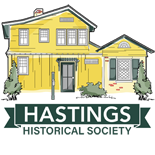
by Natalie Barry
For the last several years, I’ve been asked to come into Hillside School and talk to the 2nd graders about Hastings history. I always look forward to it, as the kids are always great fun and so appreciative of learning about our village’s past. This year, for obvious reasons, my presentation was in taped form via Zoom. The kids had follow-up questions, which their teachers collected and sent back to me. I got a kick out of their questions and thought you might enjoy them, too. (Note in particular their very first one!)
The following is what the 2nd graders asked and my written answers back.
1. When did Penny Lick come to Hastings?

Eight years ago, Ellen Sledge started Penny Lick with a push cart at the Hastings’ Farmers Market. Her ice cream was really popular. In September of 2015, Ms. Sledge opened her shop on Warburton Avenue.
2. What was rebuilt after the Sugar Refinery burned down?
After the sugar refinery burned down in 1875, the area where it used to be was abandoned for awhile.

In 1897 Colonel Federick Zinsser established a chemical company on that spot. By 1917, Zinsser Chemical had a total of 30 buildings on the waterfront. You can see many of them in the photo above.
2. What used to be on the land that Hillside is built on?
Back in the late 1800s, the land from the end of Reynolds Field all the way up to Hillside School was a summer estate. A man by the name of Alexander Birnie built the house you see here in this photo. It was located close to where the path from the school to Chemka Pool is today.

In the early 1900s, the house was made into a hospital. In the 1930s, the hospital wanted to expand, but the village said no. The hospital abandoned the building, which was torn down a couple of years later.
In 1941, the village of Hastings bought the 52 acres of land and made it into Hillside Park. In 1961, 13 acres were set aside for the new Hillside Elementary School, which sits in the middle of Hillside Park.
3. How long did the blizzard of 1947 last?
The blizzard of 1947 took everyone by surprise. They didn’t have the computers or the ability to predict storms that we have today.

The snow started on Christmas Day and ended 16 hours later on December 26th. Reports say it wasn’t windy, but the snow fell silently and steadily. Total snowfall was a little over 26 inches, as measured in Central Park in Manhattan.
Here’s a link to a short video about how New York City coped with the storm: https://www.youtube.com/watch?v=ymj0g0HcOAg
4.What was the population of Hastings back then versus now?
Going back to right after the Revolutionary War, there were very few people living here. The map below (which was drawn pretty recently – it’s not original) shows that there were only four big farms that took up our whole village. We don’t know for certain, but we think in 1785 there were less than 50 people living in our area.

By 1850, when the factories in the ravine and the sugar refinery were in operation, we have records that say our village had about 720 residents.
By 1930, with all of the factories on the waterfront in full operation, the population had grown to about 7,000. Today, we have about 7,850 residents.
5. Where and how did people get food before grocery stores were built in Hastings?
In the early 1900s, there were several small markets downtown, where people could walk in and buy their food. The photo below shows the interior of the Prospect Market on Spring Street. (Spring Street is the short road right in front of the library.) This market was owned by Fred Breyer, an immigrant from Germany who came to the US in 1899. We think he opened his store only a couple of years later.


Once telephones became available (in the 1920s), people could call in their order. The Breyer delivery truck could deliver groceries to your door.

There was a milkman who delivered milk weekly to a metal box outside your door. Many people in Hastings also had their own little patch of garden, where they grew fresh vegetables.
6. What was there to do for fun in Hastings long ago?
Kids did a lot of the same things you do today. In the nice weather, they went to the playground or went swimming. Baseball was very popular. In the wintertime, they went sledding or ice skating.

There was no pool before the 1960s, so swimming was done in swimming holes in the Saw Mill River. The photo above shows one of those swimming holes.

They used to flood the tennis courts in Reynolds Field and ice skate there!

One thing they used to do (that isn’t very popular today) is play marbles. The point of the game is to shoot your marble at your opponent’s marble, and knock it out of the circle. Kids often had their favorite, lucky marble, which they used over and over.
7. When did the land where Foodtown is change from residential to commercial?
The Chrystie family owned the property and it was residential until the 1940s. A portion of the land was sold off then and they started building the Hastings Terraces apartments in April of 1950.

A modern A&P supermarket was built on the corner in 1960. The photo above is taken from the intersection (which is called Five Corners, by the way – can anyone guess why?).
You’ll notice that the A&P, for many years, faced the street. Today, the entrance to Foodtown faces the parking lot.
8. What was the population of Hastings 200 years ago?
Hastings wasn’t a village until 1879, so we don’t have official records on the population before then. The numbers we have are for the Town of Greenburgh.

The left side of the map above shows Greenburgh (in red) within Westchester County. The little red piece at the bottom left is what is now Hastings-on-Hudson. As you can see, the Town of Greenburgh is bigger than Hastings, but smaller than the County of Westchester.
The yellowish map on the right shows New York State, with Westchester County in red. New York is a big state!
According to U.S. Census records, the Town of Greenburgh had 2,064 residents in 1820. Of that total, we think only a couple of hundred people were living in our area then.
9. Why did they build Zinsser Park?
The man who owned the chemical factory on the waterfront, Colonel Frederick Zinsser, lived in a house located on what is now Zinsser Park. He named his estate Locust Wood, and he and his family lived there for over 50 years.

Colonel Zinsser died in 1956 at age 87. His wife Emma lived there until 1965.
In the late 1960s, the village acquired the property from the Zinsser estate. The house was demolished and the property was made into baseball fields, a playground, and a community garden. It’s named Zinsser Park in Colonel Zinsser’s honor.
10. How did the bodies of water (like where the waterhole was on Main Street) turn smaller or disappear?
That is really a good question! And the answer is a little complicated.
A lot of the brooks and streams are now underground, so you don’t see them. This photo below shows a pipe next to Reynolds Field, with some of the stream still visible. You don’t see water near Reynolds Field anymore – it’s all carried by pipes underground. (You can still see the stream above ground near Chemka Pool though!)

There’s a stream underground below Broadway at Five Corners and under Main Street. So some of the water is still around, but you don’t see it.
What’s complicated is that there doesn’t seem to be as much water up at Hillside Park as there was years ago. This may have to do with climate change and the fact that it’s warmer than it used to be. We just don’t know why there are fewer and smaller ponds.
11. Why is it called Hastings-on-Hudson?
We’re not 100% sure, but legend says that our village was named by William Saunders, an owner of one of the early factories that used waterwheels. Mr. Saunders came from Hastings, England and supposedly thought our village looked a lot like his home town in England.
Our town was first called Hastings Upon Hudson, but the name was changed to Hastings-on-Hudson in 1879 when the village was officially incorporated.

In the map above of Mr. Saunders’ property, notice the name of the town — Hastings Upon Hudson. You can see Saunders Factory is marked on the map, in the middle on the right-hand side. We think it was located behind today’s Community Center.
The street that’s marked Landing Road is what is now Main Street. The body of water in the upper right-hand corner of the map is the watering hole that people used for drinking. It’s about where the Citibank parking lot is today.
12. Was HOH larger, smaller or the same 200 years ago?
Two hundred years ago (in 1821), Hastings didn’t officially exist yet. When it became a village in 1879, the size of the territory called Hastings-on-Hudson was the same as it is today.
In terms of population, though, it was much smaller. People mostly lived on farms, with some living in the downtown area. The early factories were only just getting started.

The map you see above is from a little later. It’s a bit blurry, but I wanted you to notice that — even then — there weren’t a lot of people around. The little black dots show where the houses were located, so you can see that there’s a lot property but not many houses.
The U.S. Census for 1880 (our first one as a village!) has only about 1,800 people living in Hastings. It wasn’t until around 1900-1910 that the population started booming, because all of the factories on the waterfront needed workers. That’s when many Polish, Russian, Hungarian and Italian immigrants moved into our village.
Natalie Barry is president of the Hastings Historical Society.










Informative as always,hope the kids enjoyed it as much as I did 😊nice job !
PS thanks for the 47 snowstorm video that was great 👍
Hi Natalie. Loved your Q&A with the children. They are, indeed, very engaged in stories of how Hastings used to be. My grandchildren enjoy Hastings walks that include the show and tell around how things were when we were kids and how it looks now. As an aside, I think I can remember some references to Hastings having first been considered being named Wart-on-Hudson after a notable personage in the Village by the name of Van Wart. I’m not sure if that was just a tale I heard as a kid, but I remember I thought (at the time) it would have been a hoot.
Marie –
Your memory is correct. There’s a story that a couple of guys were sitting around, talking about what to name the village. Supposedly, Van Wart joked that they should name it after him. Then Saunders proposed “Hastings” after his hometown in England. We’re really not sure if any of it is true, but it’s a great story!
There was a pool there in the 40s. We called it the Duck Pond. There were 2 Bath Houses to change clothes. There was a diving board at the deep end. There was a lifeguard. It was closed one summer because of polio.I and my friends spent a good portion of the summers there.
Leonore – We have some old clippings about the Duck Pond. I always thought they closed it because the water wasn’t clean enough. Interesting that it was polio. Thank you for sharing that information.
I have lived in Hastings for much of my life, on and off, since 1951 whenI started kindergarten. I would like to give you my history.
Additionally I am only the second family to live in the house at 16 Sheldon place so it’s quite original still.
Michael – In normal times, we have an oral historian who does videotaped oral histories. I couldn’t tell you when exactly we’ll start that up again, but I’ll give your name to him for a future session!
This was very interesting, keep these articles coming. Cannot believe how educated some of the 2nd graders sound in the questions they asked. I lived in a house on Lefurgy Ave since the day I was born till 1966 when I got married. My house had been built around 1916s as the date in the stone wall was placed there in stone when the wall was built.
Margaret – I know exactly which house that is! I walk by there all the time and admire that wall. So cool!
This history is not just for kids! I found it very absorbing and lively. The children asked wonderful questions and you provided in depth, satisfying answers.
I wonder if there’s any way to know who might have been the first person to occupy the property that became Hastings.
Thanks so much.
Hi, Nancy – Thanks for you comments! Of course the Native Americans were here before any of the Europeans, but then Dutch settler Frederick Philipse acquired the land in the 1670s and had four farms that he leased out in what would become our village. I don’t think we have records of who those first four farmers were, but I’m guessing that the historians at Philipsburg Manor in Tarrytown would know.
Outstanding. I am so proud to be a Hastings on Hudson kid. Fond memories of swimming in the Hudson every summer day and movies on the Green at Reynolds Field in the summer time. The Buccaneer was a favorite to jump off into the river.
Ringing doorbells on a Sat. night in the manor, and hide and seek all summer long. I remember selling the Hastings News for 10cents a copy at the RR station with the Kelly brothers.
That blizzard of ’47 I can still remember. My brother Dan and I had a photo taken of us sitting in the snow. I was 3 and Dan was 5. We lived on Mendham Ave then across the street from the Oakley family.
I believe the community gardens were first established during WW II by the Zinsser family to enable local residents to grow their own food (there were no problems with deer eating the produce as hunting was not controlled and dogs were not required to be leashed).
The gardens were called Liberty gardens, just as war bonds were called Liberty bonds.
Hello everyone!
My name is Max Shestyora, I am writing from Moscow.
It was very interesting to learn about your town, how it developed. At the beginning of the 20th century, the brothers of my great-grandmother Helena Moszko (Ivan, Nikolai, Fedor, Josef) lived in Hastings and worked at the factory. They originate from Molodechno, formerly Vilna region, now Belarus.
Write, I will be glad to talk!
Natalie,
Great job! We Lillards lived at 16 Croton Avenue from 1951-1994. My fond memories of our village are too much to write here but I wanted you to know how much we residents, past present and future appreciate your continued work with the Historical Society.